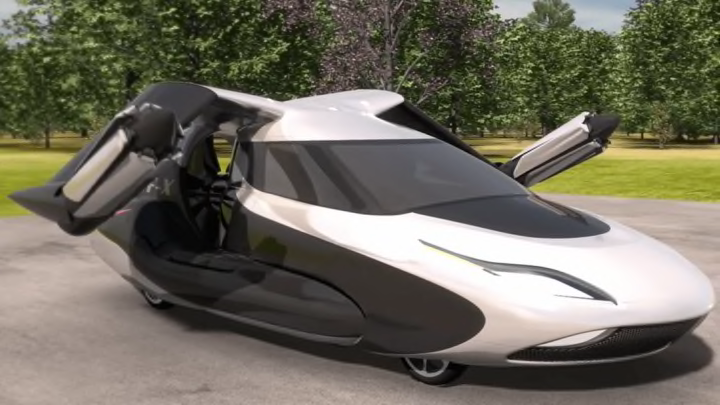9 Alternative Methods of Transit For the Future
By Christine Jun

When it comes to futuristic transportation, self-driving cars are just the beginning. Whether traveling by ground, water, or air, the ways we might get around in the future are approaching the stuff of sci-fi fantasy. These projects are worth keeping an eye on (though some are more likely to actually happen than others).
1. HYPERLOOP
Is there nothing Tesla exec Elon Musk can't do? It seems that his vision of a superfast train system that can speed you from LA to San Francisco in just 30 minutes is soon becoming a reality, thanks to a series of competitions being held by SpaceX. With linear induction motors and air compressors that help you glide on an air cushion at an astounding 760 mph, Hyperloop also promises to be cheaper, quieter, and potentially much faster than a maglev train.
2. "STRADDLING BUS"
China is already planning to implement this innovative solution to urban congestion and pollution. The beauty of Transit Explore Bus is that it makes use of already existing infrastructure in Beijing, with two lane-wide “straddling buses” that can transport up to 1400 individuals and travel up to 40 mph. The buses roll above highways on track lines 7 feet above street level and positioned between lanes of traffic, thus allowing passengers to hop on and off at elevated bus stops with ease.
3. EVACUATED TUBE TRANSPORT (ETT)
Imagine being sucked through a frictionless tube from New York to Beijing in two hours. Using superconducting maglev trains at speeds up to a little over 4000 mph, ET3 Global Alliance's pod could be 50 times faster than electric trains. It puts a whole new spin on the possibilities of super-fast transport, not to mention other lifestyle areas including global backpacking and even long-distance dating!
4. SHWEEB
Die-hard bikers, relax: You won't be left out in the future of public transit. Google has already invested $1 million in Shweeb, a human-powered monorail system employing bicycle pods. The project was one of 150,000 ideas submitted to Google's Project 10^100 in 2010. While we're still eagerly anticipating Shweeb's first planned location, you can already pedal your way up to 28 miles/hour at Agroventures in New Zealand—on your own steam, of course.
5. UNIDENTIFIED FLOATING OBJECT (U.F.O.)
Who wouldn't covet the freedom of water-jetting around the Maldives at a leisurely 3.5 knots, and in their own UFO-shaped yacht? Especially when amenities include a vegetable garden and running track on deck, as well as an underwater viewing platform below? If you don't feel like exhausting the electric motor to power your home, you can also opt for alternative energy sources via solar panels and wind/water turbines attached above and below the main UFO disc. In addition, there's a water generator that can be used for converting rain and seawater into fresh drinkable water. Sounds like smooth sailing to us.
6. DEEPFLIGHT DRAGON
This personal submarine designed by engineer Graham Hawkes applies the latest aircraft technology to transform you into an explorer of the boundless ocean. DeepFlight Dragon holds up to two individuals and has a system that handles decision-making, allowing for users to pilot the craft without much training. Once underwater, the Dragon hovers and glides around easily due to its stable quadcopter drone technology. Its super-efficient energy source—a tiny 15 Kilowatt-hour battery pack—lasts six hours between charges. All of this fun doesn't come cheap: DeepFlight Dragon has a hefty price tag of $1.5 million. Even though DeepFlight's stabilization software is still being tweaked and tested, we're already prepping a Spotify playlist for a first joyride.
7. HOVERBIKE
Expect to beat traffic by flying above it on your daily work commute on this flying motorbike. Based on the same flying principles as a tandem-rotor Chinook helicopter, movement is controlled through motorcycle-like handle grips. According to creator Chris Malloy, the Hoverbike should be able to reach an estimated height of more than 10,000 feet and reach an airspeed of 173 mph. Easy rider, indeed.
8. TF-X FLYING CAR
For those with a family, this flying car might be a better bet than the Hoverbike. Described by Boston-based company Terragfugia as "a four-seat hybrid with wings" driven by a 300-hp engine and two rotating 600-hp "pods," the TF-X will still fit in your garage. Terrafugia also claims that the TF-X will have a top airspeed of 200 mph with a range of 500 miles and an average lifespan of eight to 12 years.
That said, Terrafugia has yet to pinpoint a release date—but its main competitor, AeroMobil, is expected to launch its own flying vehicle in 2017 (though there will likely be a postponement due to a recent test flight crash). The most successful contender might actually turn out be PAL-V Europe NV's two-seat hybrid car and gyroplane, which successfully completed a maiden flight back in 2012, and just nabbed an exclusive patent in India.
9. MARTIN JETPACK
Here's your chance to finally joyride through the skies like Rocket Man, Iron Man, or a Jetson—or, if you're scared of heights, Martin Jetpack can also be flown unmanned via remote control. If you actually decide to go solo pilot, no worries; one of the safety features includes a ballistic parachute that opens as low as 20 feet above the ground. Martin expects to have a "personal jetpack" on the market by 2017 at $200,000 a pop.